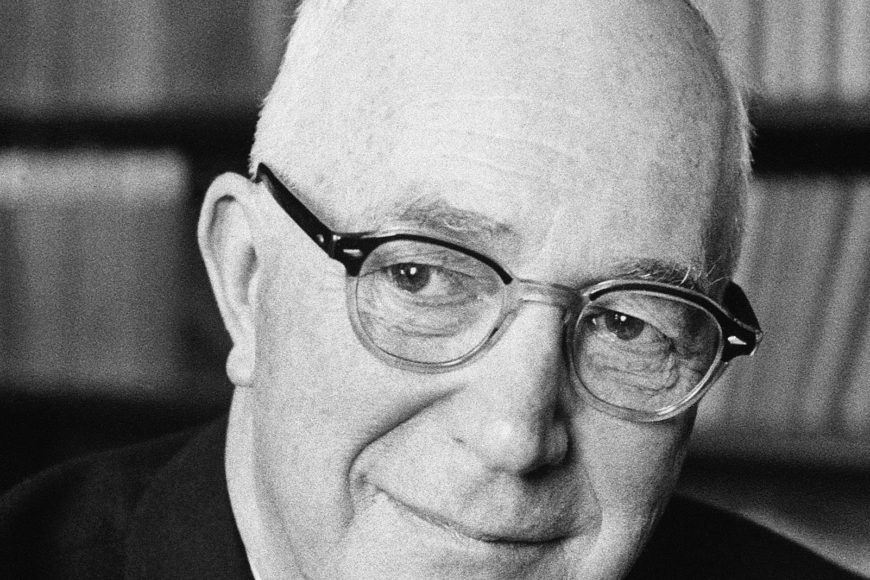Biographical data
Gordon Allport was born in Montezuma, Indiana, in 1897. As his father was a country doctor, Gordon Allport grew up among patients and nurses and all the equipment of a tiny hospital. He was the youngest of four boys born to his parents. It was written that he had a lonely childhood because he was particularly shy. When he was 22 years old, he travelled to Vienna because he had a great desire to visit Sigmund Freud. Specifically, when Allport arrived at his office, Freud simply settled into an armchair and waited for Gordon to begin as Freud wished to know the reason for his visit. Some time passed and, as Allport was unprepared for this silence, he decided to strike up a friendly conversation with Freud which focused on an observation Allport had made about a four-year-old boy with a phobia of impurity, whom he had encountered on the train. Having finished describing the boy and his pushy mother, Freud asked him if this boy was himself. Allport describes his response in these words:
Surprised and a little guilty, I managed to change the subject. While Freud’s misunderstanding of my intentions was amusing, it brought about a few thoughts. I realized that he was used to neurotic defences and that he failed to grasp as to what had really led me to his office (a rude, curious and youthful ambition). For the healing to progress, he had to get through my defences. However, in this case, the issue was not therapeutic progress. This experience taught me that depth psychology, for all its value, can go too deep, and that psychologists would do well to fully recognize overt motivations before systematically investigating the unconscious. SOURCE: Allport, 1967, p. 8.
It is particularly interesting that Allport was indeed a systematic, meticulous, orderly and consistent person – many of the characteristics that Freud associated with obsessive compulsive personality.
Allport graduated in 1922 from Harvard with a BA in Psychology, following the footsteps of his older brother Floyd, who became an eminent social psychologist. Allport worked to develop his Theory by examining social issues such as, for example, prejudice and creating personality tests. He died in Cambridge, Massachusetts in 1967.
Gordon Allport’s Personality Theory
One of the things that motivates people is the tendency to satisfy their biological survival needs which Allport called Opportunistic Function which is characterized by its reactivity, its orientation to the past and its biological colour.
Allport’s first published work which he wrote with his older brother, Floyd, focused on traits as the fundamental basis of personality (Allport & Allport. 1921). Allport argued that these traits are based on the nervous system and that they represent generalized personality predispositions that explain the stability of a person’s functioning across circumstances and across time. Characteristics are defined by three properties – frequency, intensity and range of states. For example, a very submissive person will often be very submissive in a wide range of situations.
In a classic description of personality traits, Allport and Olbert (1936) differentiated personality traits from other important units of analysis in personality research. They defined traits as “generalized and individualized determining tendencies – consistent and stable modes of adaptation of the individual to his environment” (1936, p. 36). Thus, they argue that traits are different from states and activities which describe temporary, short-lived aspects of personality that are due to external circumstances.
In conclusion, the trait concept explains behavioral stability, while the recognition of situational importance explains behavioral variability. Activity that once served an urge or some simple need now serves itself, or more broadly, serves the individual’s self-image (self-ideal). Childhood no longer has the first reason, but maturity does. (Allport, 1961)
Types of traits
Allport argued that there are 3 types of traits. These are cardinal traits, central traits and secondary dispositions. The primary trait expresses such an important and pervasive predisposition in a person’s life which virtually means that every act of his is rooted in its influence. For example, when we talk about the Machiavellian person who owes his name to the portrait of the Renaissance leader by Niccolo Machiavelli, about the sadist, who took his name from the Marquis de Sade and about the authoritarian personality who interprets almost everything with an absolute and stereotypical manner. In general, humans have few cardinal/primary characteristics. Central traits such as, for example, honesty and assertiveness, express dispositions that cover a more limited range of situations than the primary traits normally have. Secondary traits represent the less obvious, generalized, and permanent predispositions. So, Allport concludes that people have traits of varying degrees of importance and generalization.
The Self
Allport placed great emphasis on the Self moving, simultaneously, in two directions, phenomenologically and operationally. From a phenomenological perspective, Allport argued that the Self consists of those aspects of experience that we perceive as essential.
Development Theory
His operational definition became a Development Theory in itself. According to Allport, the Self has 8 functions, which must appear at certain times in a person’s life. These are the following:
- Sense of bodily “me”
- Sense of identity
- Sense of self- esteem
- Sense of self-extension
- Emergence of self-image
- Emergence of self as a rational coper
- Emergence of proproate striving (twelfth year to adolescence)
- Emergence of self as a knower (adulthood)
Sense of bodily “me” develops in the first two years of our lives. Through our own senses, we feel the closeness and warmth of our body. At the same time, within its own boundaries, our body sense warns of both pain and injury as well as touch and movement. Allport often gave a demonstration/presentation on this particular aspect of the self. He invited his audience to imagine that they were spitting into a glass and then drinking it. After that, he would ask them if anything happened and if they had any problem with it. Shortly after, he ended up saying that it was the same thing we ingest every day. The only difference is that when we swallow our saliva every day, it is produced and it stays within the body itself. However, in the demonstration, the saliva leaves the body and then enters it and, therefore, we feel somewhat strange about it because it is foreign to us.
Sense of identity also develops in the first two years of a person’s life. There is a time in our lives when we think of ourselves as continuous entities, as possessors of a past, a present, and a future. We see ourselves as distinct beings, separated and differentiated from others.
Sense of Self-Esteem (2-4 years old). During this time, we slowly come to the point where we recognize ourselves as valuable beings both to ourselves and to others. This situation is directly related to the continuous development of our abilities.
Sense of Self-Extension (4-6 years). Things, situations, people and events play a central and warm role in our very existence. “Mine” is very close to “My” as well as to “I” (me). It is worth mentioning that many people define themselves based on their parents, their spouses, their children, their tribe, their gang, their community or their nation. On the other hand, many find their identity through a profession or activity, for example, I am an oncologist, a working person or a student. Apart from the above, others define themselves based on a place, city or home. An example I could give is that if they find their car scratched, some people go through this bad experience as if the damage was done to themselves and not to their asset.
Emergence of Self-image (4-6 years old). This is “my reflection” that is, what others see. Therefore, it is the impression I would like others to form of me. It is the beginning of the consciousness of the Ideal Self.
Emergence of Self as a rational coper (6 -12 years). The child begins to develop his skills in order to be able to deal rationally and effectively with life’s problems.
Emergence of Proproate striving (12 years old to adolescence)
In this stage, future goals are believed to be built so as to give a sense of meaning to one’s life. Allport believed that a healthy person creates problems by choosing future goals that may be considered unattainable in many situations. This sense of creating these long-term goals has been defined as differentiating from other stages and, even, from having a healthy or a sick personality.
Emergence of self as a knower (adulthood)
In this final stage, the self is seen as a knower who can be aware of and surpass the other seven modes. When one goes through all the stages, one appears to use many or even all of the functions in everyday tasks and experiences.
Idiographic research
Allport became famous for his emphasis on the uniqueness of the individual. He emphasized the usefulness of idiographic research, or in other words, the in-depth study of individuals, with the aim of learning more about people in general. The idiographic approach leads to an emphasis on the type and organization of traits in the individual rather than on the position of the trait in a person relative to other people. Finally, Allport’s emphasis on the uniqueness of the individual led him to argue that for each person there are unique characteristics that science cannot capture.
Allport became known not only for his emphasis on traits but also on the concept of functional autonomy. This concept states that, although the adult’s motivations may be rooted in the child’s motivations to reduce tension, the adult (with age) becomes free of them and disengages from previous efforts to reduce tension. What initially began as an effort to reduce hunger or stress can develop into a source of pleasure and motivation.




